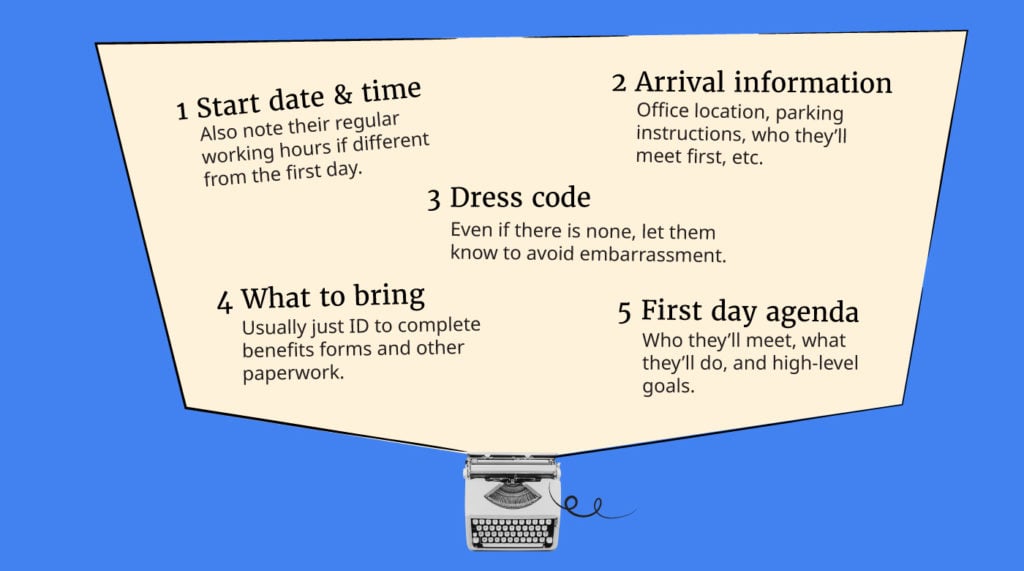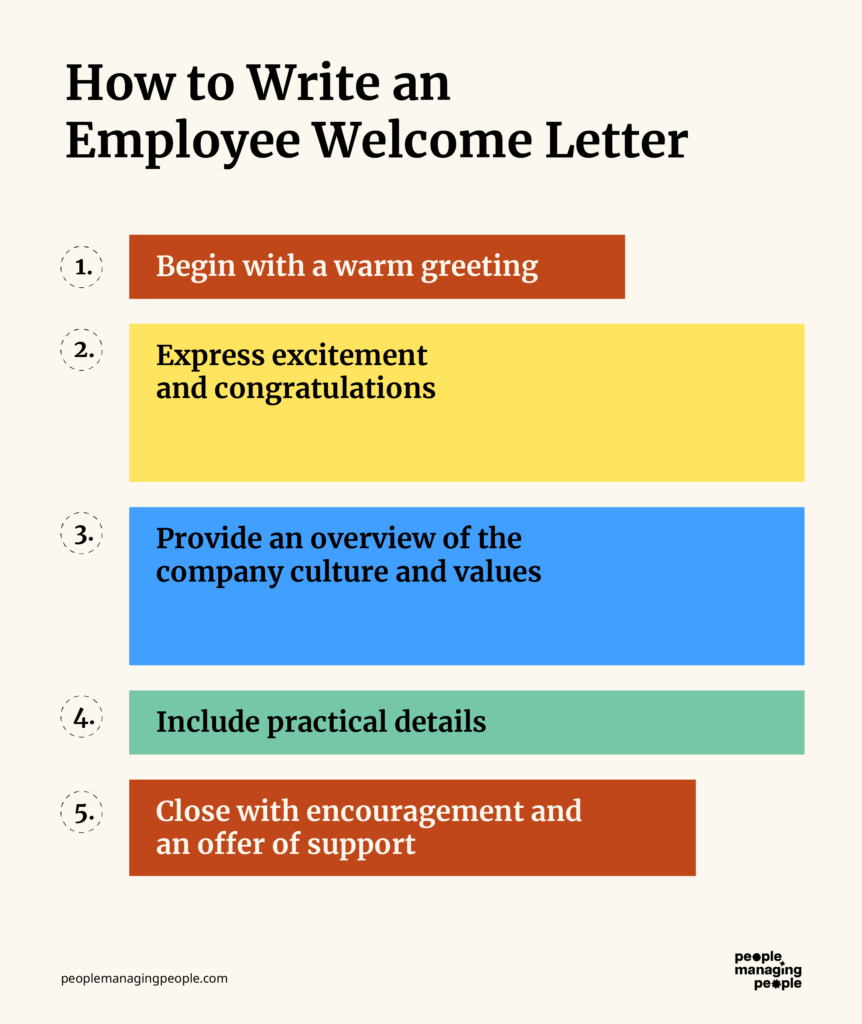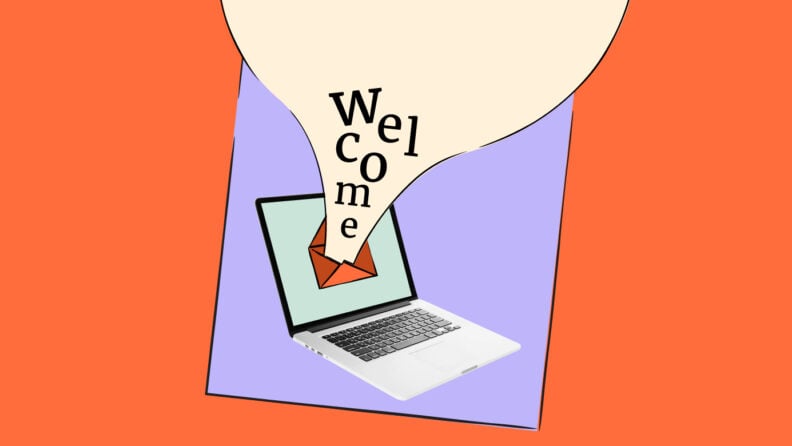Sending Warm Welcomes!: A welcome letter enhances the onboarding process by building excitement and reducing anxiety for new employees before they start, contributing to a smoother transition into the company.
The Bridge to Belonging: This letter acts as a bridge between signing the contract and starting work, helping new hires feel included and valued right from the beginning of their journey.
Setting the Stage:: By providing insights into the business and culture, a welcome letter prepares new employees for their role and fosters a sense of belonging within the team.
Sending a welcome letter to a new employee is an important first step in the employee onboarding process.
Once the employment contract is signed, and before their first day of work, you should send a welcome message to them to express your excitement and start preparing them for their first day and week of work.
This article will help you understand the ins and outs of writing a new employee welcome letter and how it contributes to a positive onboarding experience. We’ve also provided a sample welcome letter that you can use as a template to get started on creating your own.
What Is An Employee Welcome Letter?
An employee welcome letter is a document that bridges the time between date the employee first signs their employment agreement and their actual start date. It's a part of any good preboarding strategy.
The intent of the welcome letter is to introduce the company to the new hire, express excitement for their arrival, and prepare them for a smooth onboarding process.
Why Is It Important To Send A Welcome Letter To New Employees?
Sending a welcome letter to a new team member is a key part of any new hire checklist, and an important step in an effective onboarding process.
Research by Sapling shows that implementing a new hire onboarding process and structured employee orientation program is a critical part of an organization’s people and culture strategy.
Effective onboarding can have a huge positive impact on employee retention, motivation, and productivity. It’s also an important part of creating feelings of belonging and inclusion.
A warm welcome letter can help build a strong foundational core for the rest of the team member’s entire onboarding experience. The letter should:
- Build excitement and enthusiasm in advance of their first day of work;
- Ease stress and anxiety about what they can expect in their first week;
- Foster belonging and inclusion by making the employee feel like part of the team; and
- Provide valuable insight into the business and the company culture.
Pro tip: It’s important to note that the welcome letter is not a replacement for phoning or video calling the new employee immediately after they’ve accepted the job offer.
What Should You Include?

Start with a warm welcome to the company.
Begin by thanking them for choosing to become part of the team, and express how excited you are for them to start. The welcome message is also an opportunity to continue educating your new team member about the business, the culture, and how they will contribute.
Your welcome email should also communicate practical onboarding information, such as:
- Start date and time
- Arrival information
- Dress code
- What to bring on their first day
- The first-day agenda
A great welcome email might also include, either in the body of the letter itself or as an attachment to the email:
- Team member information: provide an organization chart that includes individuals on your team. They can use this together with LinkedIn to familiarize themselves with their new colleagues in advance, and remember faces and names more quickly.
- Employee handbook: send your employee handbook in advance to give them time to absorb the material at their own pace. Point out a few of the most relevant sections and key HR policies that will be most useful in their first week at work.
- New hire paperwork: paperwork is a necessary, but often boring, part of onboarding, so encourage your new team member to complete as much as possible before their first day. This frees the two of you up to focus on more interesting things in their first week.
Pro tip: as you can see, the email could be long, depending on the information you include, so you might want to preface it with a warning to your new team member to take their time in going through it all.
How to Write an Employee Welcome Letter

Step 1: Begin with a warm greeting
Start with a friendly and enthusiastic greeting. Make sure to use the employee's name and a standout detail from their interview to make it personal and welcoming.
Step 2: Express excitement and congratulations
Clearly express your excitement about the employee joining the team. Congratulate the person on their new position and affirm their decision to join the company.
Step 3: Provide an overview of the company culture and values
Briefly describe the company’s culture, values, and mission. Highlight what makes your workplace unique and how the new employee’s role aligns with these elements.
Step 4: Include practical details
Offer essential information such as the new hire's start date, expected work hours, dress code, and any items they need to bring. If relevant, provide details of the orientation process or training they will undergo, including any modules, dates, times, and locations.
Step 5: Close with encouragement and an offer of support
End the letter by encouraging them for their new journey, and offer your support for any questions or assistance they might need. Include your contact details, as well as the contact details for any other relevant HR personnel, for any further queries.
Who’s Responsible For Creating And Sending A Welcome Letter To A New Employee?
An effective welcome message to a new employee should be sent by you, as the employee’s new manager.
Larger organizations may have a human resources team who can help create the welcome message. Regardless of who creates it, the key elements should be standardized in a template to ensure that all new employees receive consistent onboarding information. Human resources is often the best equipped to coordinate this.
Once you’ve developed a welcome letter template, you can then personalize the message and add your own personal touch to the template and program to send automatically from an onboarding software platform once certain milestones have been reached in the hiring process.
Pro tip: In addition to your letter, consider having the founder or leader of your business also send the new employee a welcome message. The purpose of this message might focus more on explaining the company’s business, culture, values, vision, and mission.
How Should You Send A Welcome Message To A New Employee?
Although this article frequently refers to a welcome “letter,” you can send the message to your new employee in a variety of different ways. Whatever method you choose, you'll want to make sure the content of the message aligns with best onboarding practices.
- Email: sending a welcome email is the most effective delivery method. You can also attach additional documents, such as human resource policies or an employee handbook, and include hyperlinks to additional onboarding resources.
- Physical letter: If you choose to send a hard copy, make the letter part of a larger welcome package that gets priority couriered directly to the new employee’s home.
- Video: Videos can be highly personal, but they're not the best medium for communicating important information. Consider producing a short, generic welcome video that can be attached to any of your more detailed welcome emails.
Sample New Employee Welcome Message
Are you experiencing 'blank page syndrome'? We've created an employee welcome letter template to help get you started! Download the welcome letter through the form below.
Get our Welcome Letter template!
Give A Warm Welcome
Your welcome letter may not be your new employee's first impression, but it does provide color around who you are as an organization and set the tone for a strong start. Your employees will appreciate the personal touch!
Make sure to subscribe to the People Managing People newsletter to stay up to date with the latest thinking in HR from leadership and management experts from around the world.



